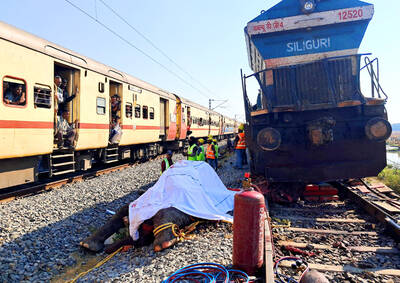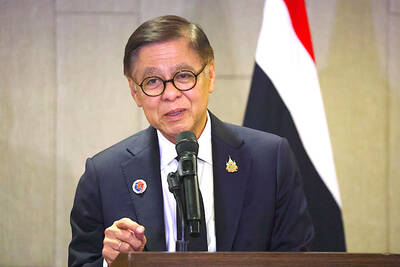As a schoolboy, Akihiro Matsumura spent hundreds of hours learning the intricate Chinese characters that make up a part of written Japanese. Now, the graduate student can rely on his smartphone, tablet and laptop to remember them for him.
“Sometimes I don’t even bother to take notes in seminars. I just take out my tablet to shoot pictures of what instructors write on blackboards,” he said.
Like millions of people across East Asia, 23-year-old Matsumura is forgetting the pictographs and ideographs that have been used in Japan and greater China for centuries.

Photo: AFP
While some bemoan what they see as the loss of history and culture, others say the shift frees up brainpower for more useful things, like foreign languages, and even improves writing as a whole.
Naoko Matsumoto, a professor of law who heads international legal studies at the prestigious Sophia University near Tokyo, said the students in her classes now write more fluently than their predecessors.
“I’m in my 40s and compared with my generation, they have more and more opportunities to write using Twitter” and other social networking services, she said.
“I think they are actually better at writing” because they write in a simple and easy-to-understand way, she said.
Priorities are changing with more emphasis placed on building logical thinking strategies — a case of content becoming more important than form.
“The skill of handwriting kanji [Chinese characters] perfectly is becoming less necessary compared with earlier times,” Matsumoto said.
Kanji developed in China as a mixture of pictographs — characters that represent a thing, like “mountain” — and ideographs — those that depict an abstract concept, like “think.”
Japan imported kanji some time during the first millennium to use as a writing system, despite there being no linguistic link between Japanese and Chinese.
By around the eighth to ninth century, it developed a syllabary — a system of consonant/vowel blends — called hiragana.
A second syllabary, called katakana, also developed. Modern-day written Japanese is a mixture of kanji, hiragana and katakana, with an increasing amount of Western script also thrown in (known as romaji or Roman letters).
In both Chinese and Japanese, computer and smartphone users need only to type the pronunciation of the kanji from the constituent sounds using either the syllabary or the alphabet. They then choose one of several options offered by the device.
“It’s easy to forget even the easiest of characters,” said Zhang Wentong, an assistant at a calligraphy center in Beijing.
“Sometimes you’ve got to think for ages. Occasionally I’ll repeatedly type the character out phonetically in my phone” until the right one pops up.
Graduate student Matsumura said his reliance on devices leaves him adrift when faced with filling in forms for repairs at the electronics shop where he works part-time.
“I sometimes can’t recall kanji on the spot while a customer is watching me,” he said. “I remember their rough shapes, but can’t remember exact strokes... It’s foggy.”
Traditionalists fear that forgetting kanji means the irrevocable loss of a fundamental part of culture.
In Hong Kong, Rebecca Ko said her 11-year-old daughter is spending more time on the computer, but she insists the child learn traditional characters and sends her to a Chinese calligraphy class.
“We cannot rely too much on computers, we should be able to write ... [and] we should be able to write neatly, it’s a basic thing about being Chinese,” she said.
However, for Matsumura, times change and the spread of technology gives people opportunities to develop their language capability in other ways, for example allowing some to read more.
“I’m one of them. I used to listen to music blankly on trains, but I now read news and other things,” he said.
Guardians of the characters say there is no evidence of any drop-off in enthusiasm. The Japan Kanji Aptitude Testing Foundation in Kyoto says the number of people who take its exam every year is holding steady at about 2 million.
People are “increasingly using text messages rather than making phone calls,” which means they need to know which characters to use, a spokeswoman said.
Yusuke Kinouchi, a 24-year-old graduate student at the Tokyo Institute of Technology, said kanji provide a certain economy, where one character can stand in for the sounds made by several letters in a language, such as English — something particularly useful on Twitter, for example, with its 140-character limit.
Moreover, “they [the characters] are beautiful,” he said.

The Burmese junta has said that detained former leader Aung San Suu Kyi is “in good health,” a day after her son said he has received little information about the 80-year-old’s condition and fears she could die without him knowing. In an interview in Tokyo earlier this week, Kim Aris said he had not heard from his mother in years and believes she is being held incommunicado in the capital, Naypyidaw. Aung San Suu Kyi, a Nobel Peace Prize laureate, was detained after a 2021 military coup that ousted her elected civilian government and sparked a civil war. She is serving a

REVENGE: Trump said he had the support of the Syrian government for the strikes, which took place in response to an Islamic State attack on US soldiers last week The US launched large-scale airstrikes on more than 70 targets across Syria, the Pentagon said on Friday, fulfilling US President Donald Trump’s vow to strike back after the killing of two US soldiers. “This is not the beginning of a war — it is a declaration of vengeance,” US Secretary of Defense Pete Hegseth wrote on social media. “Today, we hunted and we killed our enemies. Lots of them. And we will continue.” The US Central Command said that fighter jets, attack helicopters and artillery targeted ISIS infrastructure and weapon sites. “All terrorists who are evil enough to attack Americans are hereby warned

Seven wild Asiatic elephants were killed and a calf was injured when a high-speed passenger train collided with a herd crossing the tracks in India’s northeastern state of Assam early yesterday, local authorities said. The train driver spotted the herd of about 100 elephants and used the emergency brakes, but the train still hit some of the animals, Indian Railways spokesman Kapinjal Kishore Sharma told reporters. Five train coaches and the engine derailed following the impact, but there were no human casualties, Sharma said. Veterinarians carried out autopsies on the dead elephants, which were to be buried later in the day. The accident site

RUSHED: The US pushed for the October deal to be ready for a ceremony with Trump, but sometimes it takes time to create an agreement that can hold, a Thai official said Defense officials from Thailand and Cambodia are to meet tomorrow to discuss the possibility of resuming a ceasefire between the two countries, Thailand’s top diplomat said yesterday, as border fighting entered a third week. A ceasefire agreement in October was rushed to ensure it could be witnessed by US President Donald Trump and lacked sufficient details to ensure the deal to end the armed conflict would hold, Thai Minister of Foreign Affairs Sihasak Phuangketkeow said after an ASEAN foreign ministers’ meeting in Kuala Lumpur. The two countries agreed to hold talks using their General Border Committee, an established bilateral mechanism, with Thailand